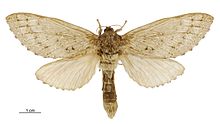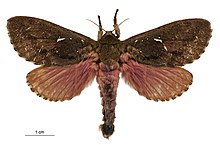Dumbletonius unimaculatus
| Dumbletonius unimaculatus | |
|---|---|

| |
| Female | |

| |
| Male | |
| Scientific classification | |
| Domain: | Eukaryota |
| Kingdom: | Animalia |
| Phylum: | Arthropoda |
| Class: | Insecta |
| Order: | Lepidoptera |
| Family: | Hepialidae |
| Genus: | Dumbletonius |
| Species: | D. unimaculata
|
| Binomial name | |
| Dumbletonius unimaculata (Salmon, 1948)[1]
| |
| Synonyms | |
| |
Dumbletonius unimaculata is a species of moth of the family Hepialidae. It is endemic to New Zealand. This species is host to the vegetable caterpillar fungus Ophiocordyceps robertsii.
Taxonomy
This species was first described by John T. Salmon as Porina unimaculata in 1948 from specimens obtained by Graham Turbott on the Three Kings Islands.[2] In 1966 Dumbleton moved the species to a new genus and gave the new combination as Trioxycanus unimaculatus.[3]
Description

The wingspan is 51–67 mm for males and 74–90 mm for females. The colour pattern of the forewings is complex in males and usually reduced or obsolete in female. The hindwings are unicolorous yellow, orange-yellow or pink.[4] The bright colouration of the hindwing of the male of the species fades rapidly after death.[5]
Adults are on wing from December to April. The larvae probably feed on fallen leaves.[4]
Distribution
Dumbletonius unimaculatus is endemic to New Zealand[6] and can be found only in the North Island where it is common.[5]
Hosts
The caterpillar of this species is a host for the vegetable caterpillar fungus Ophiocordyceps robertsii. This fungus mummifies the caterpillar then grows its fruiting body from the caterpillar's head through the soil.[5]
References
- ^ Nielsen, Ebbe S.; Robinson, Gaden S.; Wagner, David L. (2000). "Ghost-moths of the world: a global inventory and bibliography of the Exoporia (Mnesarchaeoidea and Hepialoidea) (Lepidoptera )" (PDF). Journal of Natural History. 34 (6): 823–878. doi:10.1080/002229300299282. S2CID 86004391.
- ^ Salmon, J. T. (1948). "New Species and Records of Lepidoptera from the Three Kings Islands, New Zealand". Records of the Auckland Institute and Museum. 3 (4/5): 309–311. JSTOR 42906019.
- ^ Dumbleton, L. J. (1966). "Genitalia, classification and zoogeography of the New Zealand Hepialidae (Lepidoptera)". New Zealand Journal of Science. 9 (4): 920–981 – via BUGZ.
- ^ a b Dugdale, J. S. (1994). "Hepialidae (Insecta: Lepidoptera)" (PDF). Fauna of New Zealand. 30: 58–59 – via Landcare Research New Zealand Ltd.
- ^ a b c Hoare, Robert J. B. (2014). A photographic guide to moths & butterflies of New Zealand. Ball, Olivier. Auckland: New Holland Publishers (NZ) Ltd. p. 16. ISBN 9781869663995. OCLC 891672034.
- ^ "Dumbletonius unimaculatus (Salmon, 1948)". www.nzor.org.nz. Landcare Research New Zealand Ltd. Retrieved 2017-09-28.
 Media related to Dumbletonius unimaculatus at Wikimedia Commons
Media related to Dumbletonius unimaculatus at Wikimedia Commons Data related to Dumbletonius unimaculatus at Wikispecies
Data related to Dumbletonius unimaculatus at Wikispecies
